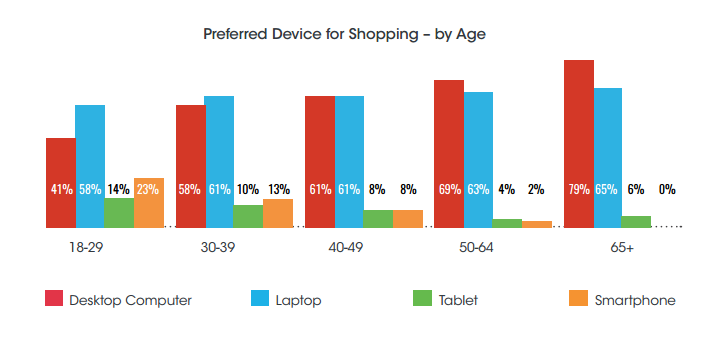Retailers and marketers across industries are well aware that consumers today are in charge. They use multiple devices, numerous channels, and are always connected. The consumer journey is disjointed and fractured among numerous touchpoints, yet consumers continue to demand more from brands and expect retailers to cater to their needs. Marketers are under more pressure than ever to unify this journey and ensure they are prioritizing just the right person with just the right message and across the channels consumers prefer.
To begin, let’s take a deeper look at the retail landscape and dive into key statistics to make sense of today’s shopping trends. Bronto Software released a three-part series of studies last year that asked consumers to tell all – how they shop, which devices they use, and what they expect from brands. Key findings from the studies include:
- Online shoppers were asked how often they shop online. In total, 60% of respondents reported shopping online at least once a month. Nearly one in four shop online at least once a week.
- More males (30%) report shopping online at least once per week compared to females (18%). While there were more female occasional shoppers (32%), males are still more actively shopping online at least once per month (62% males vs. 58% females).

- Those under 40 are the most active Frequent Shoppers with the 30-39 age group slightly edging out the 18-29 demographic by 2%.

- Mobile device ownership is on the rise with 63% of shoppers owning a smartphone, however desktop and laptop computers continue to be the most owned devices by online shoppers. However, ownership of laptops and desktops is on the decline (68% own a desktop and 76% own a laptop).

- The second most owned device for shoppers under 40 is a smartphone, while shoppers over 40 (excluding those 65+) have desktops in second place. Regarding preferred device for shopping, smartphone and tablet preferences are strongest for those under 40, with 23% of online shoppers ages 18-29 prefer shopping on a smartphone, and one in five prefer shopping on a tablet.

- Mobile apps are on the rise, however, mobile browsers continue to be the preferred choice with 61% of smartphone shoppers preferring mobile web browsers and only 39% for apps. When analyzed by age, the under-40 age group has a stronger preference for mobile apps compared to other age groups, suggesting that apps will be a strong focus area for retailers in the future.

- The third series in Bronto Software’s research ask consumers about shopping carts and expectations. A key finding revealed that 73% of online shoppers use the shopping cart to store items to buy later. According to the study, “This shows that for most online shoppers, some level of purchase intent remains when items are left in the cart. Eighteen percent of online shoppers plan to revisit items left in shopping cart every time they shop, revealing that for many, this is fundamental part of shopping online.”
- Millennials use the shopping cart to store items more often than any other age group with an astounding 88% of 18-29 year olds using shopping carts to store items and 42% storing items in the cart with plans to come back and buy every time they shop.

- Forty percent of online shoppers plan to revisit the items left in the shopping cart while in a physical store or on a mobile device. This gives further credence to the fact that shoppers start on one device or channel and often end up purchasing on another. The entire shopping journey must be optimized across devices and channels to ensure that consumers have a seamless experience at such a critical juncture before final purchase.

- Younger demographics are particularly prone to move between devices and channels before making a purchase, a trend that continue to grow.

- Shopping cart reminders can be key to a final conversion, but how consumers perceive these reminders also varied by age. Overall, 42% of online shoppers find cart reminders to be helpful. More than half of online shoppers aged 18-29 found cart reminders to be helpful, while seniors (those aged 65+) tended to view them as intrusive (32%) or annoying (37%).

- Nearly half of all online shoppers who expect to receive a cart reminder (48%) do not expect the email to contain a discount, incentive or free shipping offer. Of the remainder, more shoppers answered that they expect a reminder email to contain discounts and coupons (37%) rather than free shipping offers (15%).
- Also interesting to note is that while 74% of online shoppers expect the message to be received within 24 hours after items have been left in the cart, the largest percentage (35%) expect the messages to hit their inboxes between 12-24 hours.
Consumers Expect a Personalized Journey
As consumers traverse across each of these channels, they expect brands to understand them regardless of where they choose to engage. By 2018, Gartner predicts that organizations that excel in personalization will outsell companies that don’t by 20%. Most retailers understand that this is the new reality of today’s omnichannel world, however delivering on this promise is easier said than done.

Delivering a seamless journey can only be achieved with a real-time 360-degree view of consumers. This requires a rock-solid foundation of data – internal data sets and third-party enhancements. The time is now to break down data siloes and consolidate and democratize data across the organization. A personalized experience can only be delivered with a 360-degree view and this is next to impossible to achieve if data is sitting in separate systems such as email, POS, service departments, web browsing history, and so forth.
Although 93% of retail executives say service personalization is a strategic focus, only one-quarter of consumers feel they receive a consistent, personal experience across channels, according to findings from personalization technology provider TimeTrade.
Other notable findings from the study include:
- Only 23% of retail decision-makers plan to undertake initiatives for personalization in the next 18 months, while 8% plan to do nothing at all
- Among organizations planning improvements, training store associates was noted as the top priority (83%)
- In terms of experience improvement, the physical store is a top priority for retailers, with 45% of decision-makers ranking it ahead of other channels. Social media came in second at 19%, Web experience at 14% and call centers at 11%
- About half (51%) of consumers ranked call centers as having the poorest experience, followed by in-store with 26% of the vote and social with 23%
The Shift to Right Time Marketing
With the complexity of today’s shopping journey, the enormous amounts of data that consumers create as they engage with brands, and the expectations of hyper-personalized engagement with retailers, marketers must invest in processes to optimize engagement strategies. The movement towards right-time marketing is gaining traction and is based on blending data, technology and analytics to target the right person, through the right channel, and at the right moment.

- The Right Person: Identifying the right person through a combination of internal customer and prospect data, as well as third-party demographic and firmographic enhancement, digital data, and in-market purchase signals.
- The Right Channel: Once the right person or audience has been identified, marketers must use a multi-channel approach to target today’s consumers. As consumers go from device to device and use as many as 8 channels or more for research and purchases, marketers must continually strive to provide a seamless experience for the customer, however or whenever they decide to interact with your brand.
- The Right Moment: Consumers today are constantly bombarded with marketing messages and advertisements. Cutting through the clutter requires that you serve up the most relevant messages at the right time.
By integrating the right data across multiple channels to understand a consumer’s behaviors in the moment, retailers can find the Right Answer to meet increasing customer expectations. When targeted to the right person, through the right channel, and at the right moment, every customer interaction is an opportunity to strengthen customer loyalty, reduce churn, and boost revenues.
Learn how Porch Group Media can help you get to know your customers better and reach them across channels to boost your marketing success. Contact us to get started!





